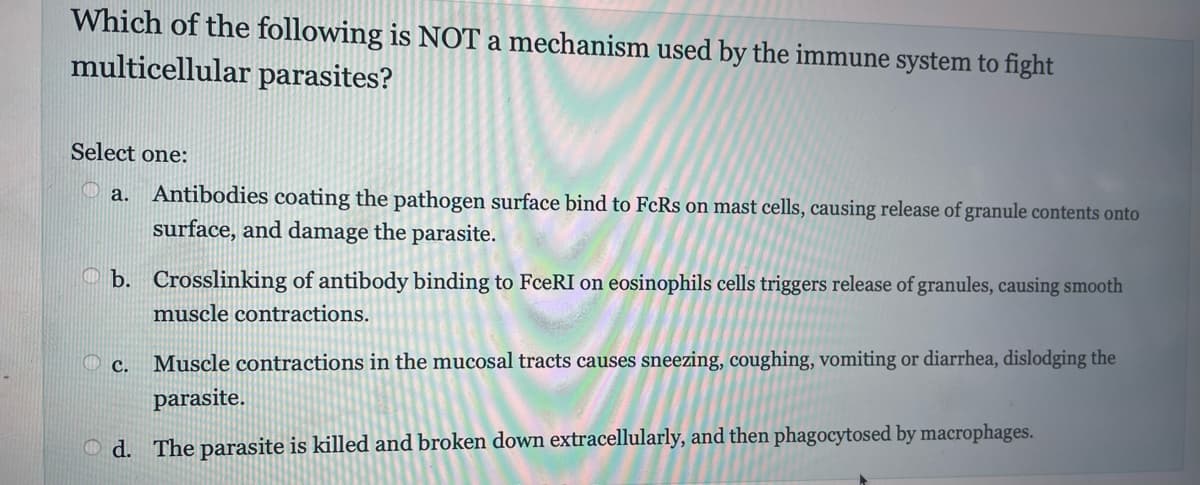Which of the following is NOT a mechanism used by the immune system to fight multicellular parasites? Select one: a. Antibodies coating the pathogen surface bind to FcRs on mast cells, causing release of granule contents onto surface, and damage the parasite. b. Crosslinking of antibody binding to FceRI on eosinophils cells triggers release of granules, causing smooth muscle contractions. Muscle contractions in the mucosal tracts causes sneezing, coughing, vomiting or diarrhea, dislodging the parasite. d. The parasite is killed and broken down extracellularly, and then phagocytosed by macrophages. C.
Which of the following is NOT a mechanism used by the immune system to fight multicellular parasites? Select one: a. Antibodies coating the pathogen surface bind to FcRs on mast cells, causing release of granule contents onto surface, and damage the parasite. b. Crosslinking of antibody binding to FceRI on eosinophils cells triggers release of granules, causing smooth muscle contractions. Muscle contractions in the mucosal tracts causes sneezing, coughing, vomiting or diarrhea, dislodging the parasite. d. The parasite is killed and broken down extracellularly, and then phagocytosed by macrophages. C.
Biology (MindTap Course List)
11th Edition
ISBN:9781337392938
Author:Eldra Solomon, Charles Martin, Diana W. Martin, Linda R. Berg
Publisher:Eldra Solomon, Charles Martin, Diana W. Martin, Linda R. Berg
Chapter38: Plant Developmental Responses To External And Internal Signals
Section38.4: Responses To Herbivores And Pathogens
Problem 1C
Related questions
Question

Transcribed Image Text:Which of the following is NOT a mechanism used by the immune system to fight
multicellular parasites?
Select one:
a. Antibodies coating the pathogen surface bind to FcRs on mast cells, causing release of granule contents onto
surface, and damage the parasite.
b. Crosslinking of antibody binding to FceRI on eosinophils cells triggers release of granules, causing smooth
muscle contractions.
Muscle contractions in the mucosal tracts causes sneezing, coughing, vomiting or diarrhea, dislodging the
parasite.
d. The parasite is killed and broken down extracellularly, and then phagocytosed by macrophages.
C.
Expert Solution
This question has been solved!
Explore an expertly crafted, step-by-step solution for a thorough understanding of key concepts.
This is a popular solution!
Trending now
This is a popular solution!
Step by step
Solved in 3 steps

Knowledge Booster
Learn more about
Need a deep-dive on the concept behind this application? Look no further. Learn more about this topic, biology and related others by exploring similar questions and additional content below.Recommended textbooks for you

Biology (MindTap Course List)
Biology
ISBN:
9781337392938
Author:
Eldra Solomon, Charles Martin, Diana W. Martin, Linda R. Berg
Publisher:
Cengage Learning

Biology (MindTap Course List)
Biology
ISBN:
9781337392938
Author:
Eldra Solomon, Charles Martin, Diana W. Martin, Linda R. Berg
Publisher:
Cengage Learning